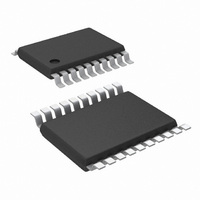LM20242MH/NOPB National Semiconductor, LM20242MH/NOPB Datasheet - Page 12

LM20242MH/NOPB
Manufacturer Part Number
LM20242MH/NOPB
Description
IC REG SYNC BUCK 2A 20TSSOP
Manufacturer
National Semiconductor
Series
PowerWise®r
Type
Step-Down (Buck)r
Datasheet
1.LM20242MHXNOPB.pdf
(20 pages)
Specifications of LM20242MH/NOPB
Internal Switch(s)
Yes
Synchronous Rectifier
Yes
Number Of Outputs
1
Voltage - Output
0.8 ~ 32 V
Current - Output
2A
Frequency - Switching
250kHz, 750kHz
Voltage - Input
4.5 ~ 36 V
Operating Temperature
-40°C ~ 125°C
Mounting Type
Surface Mount
Package / Case
20-TSSOP Exposed Pad, 20-eTSSOP, 20-HTSSOP
Dc To Dc Converter Type
Step Down
Pin Count
20
Input Voltage
36V
Output Voltage
0.8 to 32V
Switching Freq
100 to 1000KHz
Output Current
2A
Package Type
TSSOP EP
Output Type
Adjustable
Switching Regulator
Yes
Mounting
Surface Mount
Input Voltage (min)
4.5V
Operating Temp Range
-40C to 125C
Operating Temperature Classification
Automotive
For Use With
LM20242EVAL - BOARD EVAL 2A POWERWISE LM20242
Lead Free Status / RoHS Status
Lead free / RoHS Compliant
Power - Output
-
Lead Free Status / Rohs Status
Compliant
Other names
*LM20242MH/NOPB
LM20242MH
LM20242MH
www.national.com
age ripple and transient response. The output voltage ripple
can be approximated by using the following formula.
Where, ΔV
at the power supply output, R
of the output capacitor, f
and C
The amount of output ripple that can be tolerated is applica-
tion specific; however a general recommendation is to keep
the output ripple less than 1% of the rated output voltage.
Keep in mind ceramic capacitors are sometimes preferred
because they have very low ESR; however, depending on
package and voltage rating of the capacitor the value of the
capacitance can drop significantly with applied voltage. The
output capacitor selection will also affect the output voltage
droop during a load transient. The peak droop on the output
voltage during a load transient is dependent on many factors;
however, an approximation of the transient droop ignoring
loop bandwidth can be obtained using the following equation.
Where, C
L (H) is the value of the inductor, V
voltage drop ignoring loop bandwidth considerations, ΔI
STEP
capacitor ESR, V
the set regulator output voltage. Both the tolerance and volt-
age coefficient of the capacitor should be examined when
designing for a specific output ripple or transient droop target.
INPUT CAPACITOR SELECTION
Good quality input capacitors are necessary to limit the ripple
voltage at the VIN pin while supplying most of the switch cur-
rent during the on-time. In general it is recommended to use
a ceramic capacitor for the input as they provide both a low
impedance and small footprint. One important note is to use
a good dielectric for the ceramic capacitor such as X5R or
X7R. These provide better over temperature performance
and also minimize the DC voltage derating that occurs on Y5V
capacitors. The input capacitors should be placed as close as
possible to the VIN and GND pins on both sides of the device.
Non-ceramic input capacitors should be selected for RMS
current rating and minimum ripple voltage. A good approxi-
mation for the required ripple current rating is given by the
relationship:
As indicated by the RMS ripple current equation, highest re-
quirement for RMS current rating occurs at 50% duty cycle.
For this case, the RMS ripple current rating of the input ca-
pacitor should be greater than half the output current. For best
performance, low ESR ceramic capacitors should be placed
in parallel with higher capacitance capacitors to provide the
best input filtering for the device.
(A) is the load step change, R
OUT
OUT
(F) is the output capacitance used in the design.
OUT
(F) is the minimum required output capacitance,
(V) is the amount of peak to peak voltage ripple
IN
(V) is the input voltage, and V
SW
(Hz) is the switching frequency,
ESR
(Ω) is the series resistance
DROOP
ESR
(Ω) is the output
(V) is the output
OUT
(V) is
OUT-
12
SETTING THE OUTPUT VOLTAGE (R
The resistors R
voltage for the device. Table 1 provides suggestions for
R
If different output voltages are required, R
lected to be between 4.99 kΩ to 49.9 kΩ and R
calculated using the equation below.
ADJUSTING THE OPERATING FREQUENCY (R
The operating frequency of the LM20242 can be adjusted by
connecting a resistor from the RT pin to ground. The equation
shown below can be used to calculate the value of R
given operating frequency.
Where, f
frequency adjust resistor in kΩ. Please refer to the curve Os-
cillator Frequency versus R
acteristics section. If the R
not operate.
LOOP COMPENSATION (R
The purpose of loop compensation is to meet static and dy-
namic performance requirements while maintaining adequate
stability. Optimal loop compensation depends on the output
capacitor, inductor, load and the device itself.
The overall loop transfer function is the product of the power
stage and the feedback network transfer functions. For sta-
bility purposes, the objective is to have a loop gain slope that
is -20db/decade from a very low frequency to beyond the
crossover frequency. Figure 4 shows the transfer functions
for power stage, feedback/compensation network, and the
resulting closed loop system for the LM20242.
FB1
and R
TABLE 1. Suggested Values for R
SW
FB2
is the switching frequency in kHz, and R
R
for common output voltages.
FB1
FB1
short
4.99
8.87
12.7
21.5
31.6
(kΩ)
and R
R
RT
FB2
RT
FB2
open
10.2
10.2
10.2
10.2
resistor is omitted the device will
C1
10
in the typical performance char-
are selected to set the output
(kΩ)
, C
C1
)
V
FB1
0.8
1.2
1.5
1.8
2.5
3.3
OUT
FB1
, R
FB2
and R
FB2
should be se-
)
FB1
RT
FB2
RT
)
RT
can be
is the
for a










